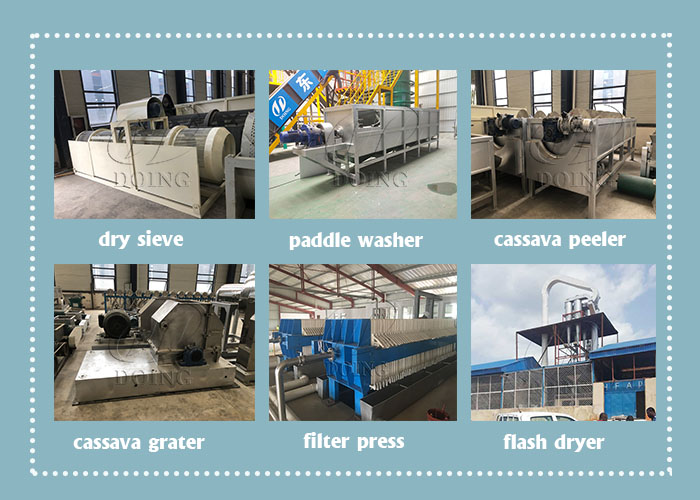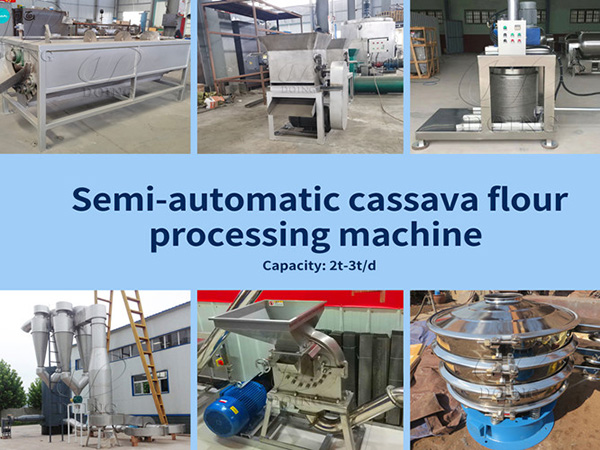 Tel/WhatsApp
Tel/WhatsApp
Cassava Meal Processing Line Layout
Cassava meal is an essential food staple in many regions, with significant market potential. The industrial production of cassava meal involves several key processing stages, each crucial to ensure high-quality output. The process can be divided into three main sections: cleaning, processing, and drying. Below is an overview of the process, along with advice for optimizing each stage.
1. Cleaning Section
The first step in cassava meal production is cleaning the raw cassava roots. Fresh cassava is first passed through a dry sieve to remove any weeds, dirt, and large impurities. After sieving, the cassava is fed into a paddle washer, where it is thoroughly washed to remove mud, stones, and smaller impurities. This ensures that only clean cassava enters the next stage.
Once cleaned, the cassava is transferred to a peeler to remove both the outer and inner skins. This step is crucial for eliminating any undesirable elements that could affect the quality of the meal.
 cassava meal processing machine
cassava meal processing machine
2. Processing Section
After peeling, the cassava roots are ready for the processing stage. The peeled cassava is fed into a grating machine, where it is shredded into a fine slurry. You can choose different machines depending on your production capacity and requirements. Options include a grating machine, hammer mill, cutting machine, or rasper machine. The right choice of equipment will depend on factors such as the desired particle size, throughput, and efficiency, and our engineers can provide expert advice on the best option for your needs.
Once the cassava is grated into a slurry, the next step is dewatering. A dewatering machine is used to remove excess water from the slurry, resulting in a solid mass known as cassava cake.
 automatic cassava meal processors
automatic cassava meal processors
3. Drying Section
The final stage involves drying the cassava cake to produce cassava meal. After dewatering, the cassava cake is sent to a powder cake crusher, which further reduces the size of the cake into smaller particles. The crushed powder is then elevated by a hoist and fed into an airflow dryer, where hot air is used to reduce moisture content and produce a dry, free-flowing powder.
Finally, to ensure a fine texture and optimal quality, the dried cassava powder undergoes a secondary crushing process using a fine crusher. This step helps to achieve the desired consistency and guarantees the high quality of the finished cassava meal.
Once all the steps are completed, the cassava meal is ready for packaging and distribution.
This layout ensures a smooth and efficient production flow, maximizing both output and quality at each stage of the process. Our engineers will assist you in selecting the appropriate machinery and settings to optimize performance based on your production needs.
-
 What is the capacity of cassava slicer manufactured by Henan Jinrui?
What is the capacity of cassava slicer manufactured by Henan Jinrui?
-
 How Much is the Cassava Agro Processing Machine Used for Cassava Flour Production?
How Much is the Cassava Agro Processing Machine Used for Cassava Flour Production?
-
 Which state in Nigeria produce the most cassava?
Which state in Nigeria produce the most cassava?
-
 Ghana kokonte flour processing facility layout and prices
Ghana kokonte flour processing facility layout and prices
-
 Boost Cassava Starch Yield and Purity with Innovative Processing Technologies
Boost Cassava Starch Yield and Purity with Innovative Processing Technologies
-
 Unlocking Nigeria's Potential: Starting a Lucrative Cassava Starch Business
Unlocking Nigeria's Potential: Starting a Lucrative Cassava Starch Business
-
 5 Must-Know Features Before Buying a Modern Cassava Starch Machine
5 Must-Know Features Before Buying a Modern Cassava Starch Machine
-
 Advantages of Modern Garri Processing Equipment Over Traditional Methods
Advantages of Modern Garri Processing Equipment Over Traditional Methods
-
 How does the manioc flour flash dryer reduce energy consumption?
How does the manioc flour flash dryer reduce energy consumption?
-
 What Kind of Engineering Service Can Henan Jinrui Offer in Garri Processing Project?
What Kind of Engineering Service Can Henan Jinrui Offer in Garri Processing Project?
-
 Henan Jinrui Secures Order from Benin for 1-Ton Daily Garri and Attieke Processing Machines
Henan Jinrui Secures Order from Benin for 1-Ton Daily Garri and Attieke Processing Machines
-
 Henan Jinrui Signed Contract to Supply Small Scale Cassava Flour Production Line to Haitian Client
Henan Jinrui Signed Contract to Supply Small Scale Cassava Flour Production Line to Haitian Client
-
 Garri Processing Equipment: A Deep Dive into Production Costs and Profitability
Garri Processing Equipment: A Deep Dive into Production Costs and Profitability
-
 Doing Factory Ships High-Quality Garri Processing Equipment to Nigeria
Doing Factory Ships High-Quality Garri Processing Equipment to Nigeria
-
 Selling High-Quality Cassava Processing Equipment to Uganda
Selling High-Quality Cassava Processing Equipment to Uganda
CONTACT US
DOING company offers cassava processing machine from single machine to the complete production line. If you want to get more details about cassava processing machine, please contact us:
- Do you want to buy machine?
- Yes, I want to buy machine
- No, I want to learn more in advance.
- What is your raw material?
- Cassava
- Potato
- Sweet potato
- Others
- 2. What is the final product you want to produce?
- Garri
- Cassava flour
- Cassava starch
- Cassava chips
- Attiekie
- Bammy
- Others
- 3.What is your capacity plan?
- Small scale garri machine
- 1ton per day
- 2tons per day
- 3tons per day
- 10tons per day
- 20tons per day
- Others
- 3.What is your capacity plan?
- Small scale
- 5tons per day
- 10tons per day
- 20tons per day
- 50tons per day
- 100tons per day
- Others
- 3.What is your capacity plan?
- Small scale
- 5tons per day
- 10tons per day
- 20tons per day
- 50tons per day
- 100tons per day
- 200tons per day
- 300tons per day
- Others
- 3.What is your capacity plan?
- Small scale
- Middle type
- Large scale
- What is your capacity plan?
- Small scale
- 5tons per day
- 10tons per day
- 20tons per day
- 50tons per day
- 100tons per day
- 200tons per day
- 300tons per day
- Others








